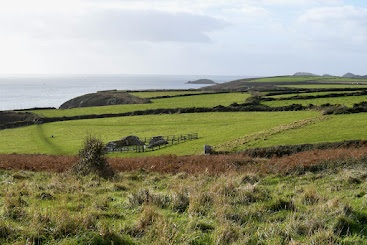Holy wells can be found in the most beautiful places –
 |
| Site of St. Non's Well |
 |
| The carn above Llanwnda Well |
– or… they can’t be found at all. Although Pembrokeshire is reputed to have 276 wells, there are many which have disappeared, or have become impossible to reach, due to changes in landscape and neglect by us all. I myself couldn’t find St Teilo’s the day I went looking for it. The roads around where it should be were so narrow and winding that it was difficult to stop. It is also said to be situated on private land – which is certainly true of others, and therefore they cannot be visited without the permission of the owner.
Between these two extremes are those wells in surprising or rather unsuitable places.
Perhaps the most extreme example of this is the well in St Bride’s Inn in Little Haven.
 |
| St. Bride's Inn, Little Haven |
 |
| Well at St. Bride's Inn |
The well is actually situated through a door at the back of the bar. It has ‘shelves’ on either side, which look as if they would serve as seats for pilgrims to rest and bathe their feet, but have been more recently used as somewhere to cool beer-barrels. The owner of the Inn told me that it used to supply the water to the village, and indicated where the pipes carrying that water ran. He had no idea that there may be any ‘holy’ significance to the well. Perhaps he is right, and yet, with the pub being called St Bride’s, (Sant Ffraid), who knows?
Another rather inappropriate well-site, is that to be found along Solva harbour.
 |
| Well at Solva Harbour |
Where it is now is between a toilet block and a large boat (although the latter spends some of its time in the sea, hopefully). It seems such a shame that whoever decided to site a Public Convenience there didn’t see any value or beauty in the well.
The same can be said for the construction of the road leading to Whitesand’s beach which edges St Aidan’s (St Maedog’s) well to the side, and caused it to dry up. True, the well as it is now, isn’t a very appealing structure…
 |
| St. Aidan's Well, Whitesands |
… but it still has a significance as belonging to Aidan, a student of St David, founder and first bishop of Ferns, who has so many stories told about him… bringing the drowned back to life, taking bee hives back to Ireland, defeating an army. And it has some wonderful views from it, across to Carn Llidi – if only one didn’t have to stand in the road to appreciate them.
 |
| View of Carn Llidi from St. Aidan's Well |
And then there are wells in gardens, in church-yards, in car-parks (or boat-parks, rather) as in Porthclais.
 |
| Well at Porthclais |
This well is known as St David’s well (Ffynnon Ddewi) and is said to be where St David was baptised by St Elvi (Ailbhe, Aelbyw or Elvis) (although there is also a St Elvis’s well near Solva, which also lays claim to the baptism). Surely a very important connection and a site to look after. And yet, as it is now, it is very difficult to find and is very much overgrown.
And, in addition to wells being found in strange places, there are a surprising list of strange objects to be found where they are.
That well at St Bride’s, for example, is guarded by an inflatable Welsh dragon.
At Whitchurch well, you can pick up a pebble from the bottom of the water which is red on one side and white underneath. I had read about this, but was still surprised to see how the clear the colours were, and the distinction between them.
 |
| Well at Whitchurch |
 |
| Pebble from Whitchurch Well |
Of course, there are the usual offerings typical of wells, which may be found in the water or at the side of the well. Coins, pebbles, rags, candles.
And, although it is no longer there, for many years the skull of St Teilo was kept at his well, as a ladle to scoop the water from it.
No picture of this, but if anyone wants to see it, it is, apparently, in Llandaff Cathedral – or, at least, the top of it!
Strange, indeed!




